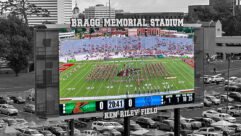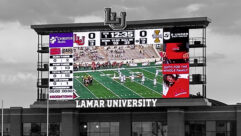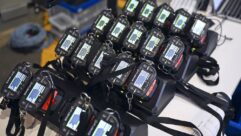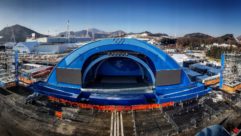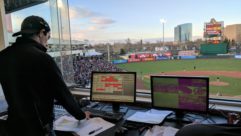Arena and Stadium Wi-Fi
Apr 10, 2014 11:39 AM
Creating the fan experience
Chuck Lukaszewski, Sr. Director of Engineering, Aruba Networks
Are most arenas and stadiums using Wi-Fi to enhance the fan experience? Or do they also use the network to support internal applications, such as getting content to digital signage and connectivity for point-of-sale terminals? What are the pros and cons of piggybacking internal applications on the Wi-Fi network?
Fans want an immersive experience, whether they are viewing at the stadium or at home and the availability (or not) of this impacts where they will watch the game. Most recent Aruba stadium and arena deployments are using the Wi-Fi primarily to enhance the fan experience and improve the retention of fans to live events to compete more effectively with the home viewing experience and deliver the best live experience. They are leveraging stable Wi-Fi networks to deliver video to the fans in their seat so that they can access on-demand instant replays or other in-game footage as well as look up relevant statistics on the teams and players. Mobile engagement apps that integrate with the Wi-Fi systems and enable location-based notifications and directions are being deployed and made available for fans to be able to place concessions orders from the comfort of their seat as well as for locating facilities such as the nearest restrooms, exits and fan club stores. This enables the facility operators to deliver a better experience for the fan while also being able to attract higher revenues from attendees. Mobile engagement and stable Wi-Fi have become critical to getting fans to attend live events, rather than watch from home.
Most stadiums/arenas also use the network to simultaneously support internal applications including point-of-sale and stadium operations (ticket scanning, communications, press photo transfer). This approach can result in significant cost savings as it eliminates the need to deploy and support two networks. The challenge with this approach is that the network and equipment must be designed and configured to ensure security as well as deliver Quality of Service (QoS) for business-critical applications.
Therefore, when our partners work with stadium/arena customers to design their networks, one of the key considerations is identifying the user roles (fan, press, business-operations), then applying the appropriate security policies and segregating the traffic, based on those roles. The IT organizations configure their Wi-Fi systems to deliver QoS priority to the most business-critical applications such as point-of-sale and communications.
What kinds of RF issues are there in arenas and stadiums? For example, are there unexpected sources of interference, such as the personal Wi-Fi hotspots that some fans bring to games, or microwaves in the concession areas? How do you deal with those? What about extending coverage to the middle of the playing surface for times when the facility is used for concerts, tradeshows, and other non-game events?
Wi-Fi operates in unlicensed frequencies in the 2.4GHz and 5GHz band. Because the bands are unlicensed, anyone can use them so they are popular for delivering many types of services from video cameras to Bluetooth headsets to coach communication systems to wireless microphones used in concerts. These are non-Wi-Fi sources. And individuals with smartphones that forget to disable their Wi-Fi hotspot mode also contribute to interference to a degree.
Stadiums continuously monitor the air with spectrum analyzers, either dedicated analyzers or select Wi-Fi AP’s that have built-in spectrum analysis to identify non-Wi-Fi interfering sources and work to eliminate them. This can be relatively simple, as in the case of a fixed wireless continuously transmitting camera where it can be moved to a better channel. Or it can be difficult for mobile sources that do not transmit on a regular basis. It’s a constant effort requiring continuous surveillance and remediation. Fortunately, some Wi-Fi management systems have integrated spectrum, reporting capabilities that can proactively inform the administrators of new interference sources so they don’t need to perform continuous manual checks.
Mi-Fi device interference varies by night. In general there is very little that can be done to mitigate it from the Wi-Fi infrastructure. The long-term solution here is for carriers to work with their handset vendors to come up with ways to disable Mi-Fi functionality when they are inside a high-density environment being served by a cellular DAS and a controller-based Wi-Fi infrastructure.
Regarding extending coverage to the middle of the playing surface for times when the facility is used for concerts, tradeshows and other non-game events, this is typically done with specially located APs at the field wall for an outdoor venue, or from overhead catwalks in indoor arenas.
If a venue operator or franchise is getting ready to implement facility-wide Wi-Fi, what could or should it put in the RFP to make the infrastructure as flexible and future-proof as possible? For example, should they deploy 802.11ac?
In general, all new stadium Wi-Fi networks should be leveraging the latest AP models including 802.11ac. One of the most important reasons for this is the increased CPU and memory capacity of next-generation APs. This actually allows them to handle more non-11ac traffic than previous generations. So even if client populations are not yet 11ac, a venue owner can realize an immediate performance gain with current devices. In the future, as the market transitions to 11ac devices, having 11ac APs in place allows each device to complete data transfers more quickly. This allows the network to support more users and provide more overall capacity.
Arena and Stadium Wi-Fi
Apr 10, 2014 11:39 AM
Creating the fan experience
Bruce Miller, VP of Product Marketing at Xirrus
What kinds of companies are franchise owners and venue operators using when they decide to add public Wi-Fi to their arena or stadium? For example, the American Airlines Center chose AT&T, while the Orlando Magic chose AmpThink, so it seems to be quite a variety.
As suggested, there are a variety of different companies involved in deploying and operating stadium Wi-Fi. Carriers, as suggested, are involved in many of them, as well as large integrators and smaller companies that specialize in the business. DAS (Distributed Antenna Systems) are sometimes installed as part of the same project. The design and implementation of wireless in high-density venues like these is challenging, so dedicated resources specializing in wireless within these organizations are typically driving the projects. Customized installation is typically involved, as these types of venues have a wide variety of physical attributes and layouts. Once installed, the operation of the wireless network is usually run as a managed service rather than by a local IT team.
Are most arenas and stadiums using Wi-Fi to enhance the fan experience? Or do they also use the network to support internal applications, such as getting content to digital signage and connectivity for point-of-sale terminals? What are the pros and cons of piggybacking internal applications on the Wi-Fi network?
It is increasingly the case that Wi-Fi is being used to enhance the experience and keep people coming back to games. In many cases, they are competing with the 65in. LCD and La-Z-Boy. A wide variety of services can be run over the wireless to interact with fans as well as drive revenue. Examples include video replay, game/player statistics, concession and merchandise ordering, wayfinding within the facility, betting, and social media. Revenue can be driven through advertising, sponsorships, and retail transactions. In addition, these networks are commonly used for internal purposes such as ticketing, POS, signage, and communications.
Multi-radio, multi-use infrastructure, such as that supplied by Xirrus, can be segmented to enable simultaneous operation of different services over the same infrastructure. But special care must be taken to design the network with sufficient capacity and separation to allow this. RF spectrum is at a premium in highly dense environments such as stadiums, so the up-front design must be done to accommodate all the planned use cases.
What kinds of RF issues are there in arenas and stadiums? For example, are there unexpected sources of interference, such as the personal Wi-Fi hotspots that some fans bring to games, or microwaves in the concession areas? How do you deal with those? What about extending coverage to the middle of the playing surface for times when the facility is used for concerts, tradeshows and other non-game events?
The biggest challenge is how to support the sheer numbers of devices that are accessing the network with the limited amount of Wi-Fi spectrum available. There are only 24 Wi-Fi channels available in the US, and Wi-Fi is ultimately a shared medium – multiple users per channel. So care must be taken in designing the layout of the Wi-Fi equipment such that channels can be re-used repeatedly throughout the facility. Physical isolation of access points from each other is key to this, ideally from walls, beams, or other barriers within the building structure itself. Interference is another big challenge and can come from a number of sources. Personal Wi-Fi hotspots are increasingly popular, though we see more of these in convention/conference centers than we do in stadiums.
Other sources include other wireless systems (Zigbee, Bluetooth, etc.) in use, microwaves as mentioned, and other non-controlled Wi-Fi systems. In addition, the smartphones people carry with them can cause issues. Those not connected to the Wi-Fi network will periodically send out requests to connect, filling up the RF spectrum with extraneous transmissions that reduce the bandwidth available for valid communications. Xirrus has a product feature called Honeypot that automatically connects these smartphones to a dead-end network, at which point they stop sending out connection requests and therefore free up spectrum usage. Interference mitigation can be done with directional antennas (pointing away from the interference), careful RF planning/tuning, and robust wireless IDS/IPS, which can detect and potentially mitigate issues. Regarding extension of coverage to the playing surface, temporary equipment, such as the Xirrus Rapid Deployment Kit (RDK), can be easily set up using tripods to accommodate the wireless gear.
If a venue operator or franchise is getting ready to implement facility-wide WI-Fi, what could or should it put in the RFP to make the infrastructure as flexible and future-proof as possible? For example, should they deploy 802.11ac?
The flexibility and capability of the infrastructure equipment is the most important consideration. The latest, greatest wireless technologies such as 802.11ac may help somewhat, but are far from the most important considerations. Most devices being used on the Wi-Fi in these venues (smartphones) do not operate anywhere near the maximum rates of 11ac or 11n.
Some important considerations for an RFP would include:
- Multi-radio solutions – high-radio-count equipment to increase user density per AP and reduce the number of APs (and associated infrastructure) required
- Broad product family – a range of different types of products is typically needed to deploy a robust wireless network, e.g., both indoor and outdoor gear, low- and high-radio-density APs, and a variety of antennas
- Upgradability – software programmability and/or hardware modularity to ensure that the infrastructure can be adapted to handle changing/growing requirements
- Traffic control – ability to filter unwanted traffic, control multicast, and rate-limit traffic
- RF optimization – granular control to fine-tune the RF to optimize performance, e.g., 1) RF tuning flexibility – ability to tune transmit power very low to increase isolation and tune receive sensitivity to reduce effective cell sizes; 2) features such as Honeypot to help clean the RF spectrum; 3) Directional antennas to control RF coverage patterns and reduce interference between Aps
- Integrated diagnostics – built-in tools to test and troubleshoot the wireless network when there are issues
Arena and Stadium Wi-Fi
Apr 10, 2014 11:39 AM
Creating the fan experience
Bill Anderson, a consultant at AmpThink
What advice would you give franchise owners and venue operators that are considering adding Wi-Fi to their arena or stadium? For example, the Magic emphasized the importance of owning the network to control the data and thoroughly vetting potential contractors to ensure that they really know the nuts and bolts of Wi-Fi, such as RF engineering and capacity planning.
I have a number of thoughts, some of them echo Orlando’s comments:
In general, I agree with the Magic that it is in a venue’s best interest to own their network. I say this because unless they own the network, they could be precluded from leveraging that network to develop fan-facing applications that leverage Wi-Fi. Today, the business case for owning your own Wi-Fi is unproven. If the business case develops, and I believe it will, owning the network will ensure that the venue is positioned to reap the benefits of the installation.
With the above in mind, building and operating a high density network is expensive. Some venues may simply not be able to afford to own their Wi-Fi. If this is the case, craft the agreement with the 3rd party operator carefully. Make sure that the venues other services (concessions, ticketing, back office, etc.) can be integrated into a single Wi-Fi network. Make sure that the venue has the ability to receive reporting on who is using the data and how. Ask the operator to implement a portal that captures user data and reports that to the team for integration into their marketing efforts.
Address aesthetic requirements up front. If the install team is allowed to install without direction and the venue is unhappy with the results, there will be conflict. The two possible outcomes are both problematic. There will either be re-work (expensive) or the venue will have to settle with something they don’t like.
Make sure the RF design team is experienced and knows what they’re doing. Check references and ask to speak with other venues they have built that are being heavily used. There are a lot of stadiums with limited Wi-Fi deployments that don’t or won’t stand up to heavy use. The designer/installer needs to be able to reference more than a team that they’ve worked with or a venue they’ve installed. They need to be able to reference a venue they designed that is operating under load. Ask about the max number of concurrent connections that the installed network supports. Ask how much Wi-Fi traffic is flowing over the network. A poorly designed network will fail. People remember a bad experience long after they’ve forgotten a good experience.
Are most arenas and stadiums using Wi-Fi to enhance the fan experience? Or do they also use the network to support internal applications, such as getting content to digital signage and connectivity for kiosks?
Today, most venues have some form of wireless network that is in use to support internal applications (venue facing). The most important applications driving the need for venue facing networks are ticketing and concessions (including POS systems and kiosks). In general, we see digital signage deployed as a wired service. Most venues also support some level of connectivity for employee devices (laptops, smartphones, and tablets) although it may be limited to office areas.
Some venues have also implemented a guest or fan facing network. The scope of the fan facing network varies. Some venues elect to focus on premium areas (suites, clubs, party decks, and so on) as a way to differentiate that experience from the standard fan experience. Some elect to provide the network for the entire venue. Moving forward, we are expecting to see more interest in total venue networks capable of supporting all of the fans that could be in the building.
Once there is a comprehensive fan-facing network in place, there are a lot of ways to use that network. But, we’re not seeing many places where there is a mature application strategy to compliment the network. An exception would be a venue like Barclay’s where there is an in-seat video service leveraging Cisco’s Stadium Vision Mobile platform. There are others, but the list is limited.
In most venues the only widely deployed fan facing Wi-Fi app running on the network is a team app. Recently, we had the opportunity to participate in conversations around usage of team apps in venues and in particular video services at a major event. We were surprised when we heard that the app vendor expected less than 3 percent of the fans to use the video service during the game. In a number of venues we support, we consistently see 20 percent or more of the fans connect to the network and that number is growing. But we don’t see that growth being attributed to in venue apps. If you look at how fan facing networks are being used today, the dominant use is social media.
What kinds of RF surprises have you encountered in arenas and stadiums? For example, are there unexpected sources of interference, such as the personal Wi-Fi hotspots that some fans bring to games, or microwaves in the concession areas? How do you deal with those?
Interference is always a big issue in a public venue. We spend considerable time identifying and mitigating interference sources during the design and tuning processes. Interference comes from a variety of sources:
In some venues we encounter venue owned non-Wi-Fi devices that operate in the same frequencies. These can be things like cordless phones, wireless cameras, lighting controls, pyro-technic systems, remote controls, and so on. We address these interferers through education. We explain the impact of the device on the system and help the venue understand what that will mean for their applications or for the fan experience. In general, these interferers are addressed by the venue by replacing these devices with something similar that doesn’t operate in the same frequencies that Wi-Fi uses or by switching to a Wi-Fi version of the same equipment.
In most venues, during events, we encounter broadcast or event related systems that interfere. We recommend that our clients employ someone in a frequency coordination role and that they publish their wireless use guidelines. This allows the people who will be attending in support of the event to plan to bring the right kind of equipment to prevent conflict with the Wi-Fi system. When these interferers pop up, the policy allows the venue to ask to have the offending system shutdown.
Yes, we also see hot spots. In general, the best way to address hot spots is by providing an alternative in the venue and then promoting that network. When the Wi-Fi network is properly advertised, we don’t see hot spots as an issue unless the network performs poorly. Then, hot spots will proliferate.
The biggest surprise I’ve had recently in my work in stadiums is the growth of fan content and its impact on these networks. As few as two years ago, the dominant use of the network was downloading content. At recent big events that we’ve been involved in, inbound and outbound traffic are even and at times, uploads exceed downloads. The amount of image and video content coming from fan smartphones and tablets is radically changing the way we design these networks and our thoughts on the current set of tools provided by the vendors we implement.
If a venue operator or franchise is getting ready to implement facility-wide WI-Fi, what could or should it put in the RFP to make the infrastructure as flexible and future-proof as possible? For example, should they deploy 802.11ac? Should they consider 802.11ad? Something else?
I think the first thing the venue should do is to hire an experienced RF design team and develop the design before they go to RFP. The questions you posed are the types of issues that can be addressed in the design process and then clearly articulated in the RFP. Unfortunately, many venues are soliciting the manufacturers for the design work as part of the RFP. They don’t want to include the design work because they want a fair RFP that will give them the best system at the best price.
This approach is just wrong headed. Imagine building an RFP to develop a new stadium without a design. When you build a stadium, you hire an architect first, then you bid the building. Why do we do something else in the technology world? There are companies that can develop a design that would work for multiple manufacturers. We do it all the time and when we complete our design, the venue bids that design out. I think it is important to remember that although a design can be expensive, it is typically less than 5 percent of the total cost of the network. And, there can always be two RFPs; one for a consultant to lead the design and possibly supervise the installation and one to construct and tune the network.
Wi-Fi is evolving quickly, particularly technologies related to high density deployments. By hiring an experienced team to lead the development of that network (and possibly the RFP) before settling on the implementation details will ensure that the solution is current, cost effective, and addresses the venues needs.


